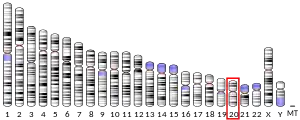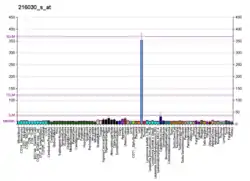| SEMG2 | |||||||||||||||||||||||||||||||||||||||||||||||||||
|---|---|---|---|---|---|---|---|---|---|---|---|---|---|---|---|---|---|---|---|---|---|---|---|---|---|---|---|---|---|---|---|---|---|---|---|---|---|---|---|---|---|---|---|---|---|---|---|---|---|---|---|
| Identifiers | |||||||||||||||||||||||||||||||||||||||||||||||||||
| Aliases | SEMG2, SGII, semenogelin II, semenogelin 2 | ||||||||||||||||||||||||||||||||||||||||||||||||||
| External IDs | OMIM: 182141 HomoloGene: 129832 GeneCards: SEMG2 | ||||||||||||||||||||||||||||||||||||||||||||||||||
| |||||||||||||||||||||||||||||||||||||||||||||||||||
| |||||||||||||||||||||||||||||||||||||||||||||||||||
| |||||||||||||||||||||||||||||||||||||||||||||||||||
| |||||||||||||||||||||||||||||||||||||||||||||||||||
| Wikidata | |||||||||||||||||||||||||||||||||||||||||||||||||||
| |||||||||||||||||||||||||||||||||||||||||||||||||||
Semenogelin-2 is a protein that in humans is encoded by the SEMG2 gene.[3][4][5]
The secreted protein encoded by this gene is involved in the formation of a gel matrix that encases ejaculated spermatozoa. Proteolysis by the prostate-specific antigen (PSA) breaks down the gel matrix and allows the spermatozoa to move more freely. The encoded protein is found in lesser abundance than a similar semenogelin protein. The genes encoding these two semenogelin proteins are found in a cluster on chromosome 20.[5]
See also
References
- 1 2 3 GRCh38: Ensembl release 89: ENSG00000124157 - Ensembl, May 2017
- ↑ "Human PubMed Reference:". National Center for Biotechnology Information, U.S. National Library of Medicine.
- ↑ Ulvsback M, Lazure C, Lilja H, Spurr NK, Rao VV, Loffler C, Hansmann I, Lundwall A (Oct 1992). "Gene structure of semenogelin I and II. The predominant proteins in human semen are encoded by two homologous genes on chromosome 20". J Biol Chem. 267 (25): 18080–4. doi:10.1016/S0021-9258(19)37155-8. PMID 1517240.
- ↑ Peter A, Lilja H, Lundwall A, Malm J (Apr 1998). "Semenogelin I and semenogelin II, the major gel-forming proteins in human semen, are substrates for transglutaminase". Eur J Biochem. 252 (2): 216–21. doi:10.1046/j.1432-1327.1998.2520216.x. PMID 9523691.
- 1 2 "Entrez Gene: SEMG2 semenogelin II".
Further reading
- Lilja H, Lundwall A (1992). "Molecular cloning of epididymal and seminal vesicular transcripts encoding a semenogelin-related protein". Proc. Natl. Acad. Sci. U.S.A. 89 (10): 4559–63. Bibcode:1992PNAS...89.4559L. doi:10.1073/pnas.89.10.4559. PMC 49122. PMID 1584792.
- Schneider K, Kausler W, Tripier D, et al. (1989). "[Isolation and structure determination of two peptides occurring in human seminal plasma]". Biol. Chem. Hoppe-Seyler. 370 (4): 353–6. doi:10.1515/bchm3.1989.370.1.353. PMID 2757795.
- Lundwall A (1996). "The structure of the semenogelin gene locus--nucleotide sequence of the intergenic and the flanking DNA". Eur. J. Biochem. 235 (3): 466–70. doi:10.1111/j.1432-1033.1996.00466.x. PMID 8654389.
- Malm J, Hellman J, Magnusson H, et al. (1996). "Isolation and characterization of the major gel proteins in human semen, semenogelin I and semenogelin II". Eur. J. Biochem. 238 (1): 48–53. doi:10.1111/j.1432-1033.1996.0048q.x. PMID 8665951.
- Kise H, Nishioka J, Kawamura J, Suzuki K (1996). "Characterization of semenogelin II and its molecular interaction with prostate-specific antigen and protein C inhibitor". Eur. J. Biochem. 238 (1): 88–96. doi:10.1111/j.1432-1033.1996.0088q.x. PMID 8665956.
- Bjartell A, Malm J, Moller C, et al. (1997). "Distribution and tissue expression of semenogelin I and II in man as demonstrated by in situ hybridization and immunocytochemistry". J. Androl. 17 (1): 17–26. doi:10.1002/j.1939-4640.1996.tb00582.x. PMID 8833737. S2CID 20337870.
- Ulvsbäck M, Lundwall A (1997). "Cloning of the semenogelin II gene of the rhesus monkey. Duplications of 360 bp extend the coding region in man, rhesus monkey and baboon". Eur. J. Biochem. 245 (1): 25–31. doi:10.1111/j.1432-1033.1997.00025.x. PMID 9128720.
- Lövgren J, Airas K, Lilja H (1999). "Enzymatic action of human glandular kallikrein 2 (hK2). Substrate specificity and regulation by Zn2+ and extracellular protease inhibitors". Eur. J. Biochem. 262 (3): 781–9. doi:10.1046/j.1432-1327.1999.00433.x. PMID 10411640.
- Malm J, Hellman J, Hogg P, Lilja H (2000). "Enzymatic action of prostate-specific antigen (PSA or hK3): substrate specificity and regulation by Zn(2+), a tight-binding inhibitor". Prostate. 45 (2): 132–9. doi:10.1002/1097-0045(20001001)45:2<132::AID-PROS7>3.0.CO;2-3. PMID 11027412. S2CID 35309283.
- Deloukas P, Matthews LH, Ashurst J, et al. (2002). "The DNA sequence and comparative analysis of human chromosome 20". Nature. 414 (6866): 865–71. Bibcode:2001Natur.414..865D. doi:10.1038/414865a. PMID 11780052.
- Brillard-Bourdet M, Réhault S, Juliano L, et al. (2002). "Amidolytic activity of prostatic acid phosphatase on human semenogelins and semenogelin-derived synthetic substrates". Eur. J. Biochem. 269 (1): 390–5. doi:10.1046/j.0014-2956.2001.02667.x. PMID 11784334.
- Lundwall A, Bjartell A, Olsson AY, Malm J (2003). "Semenogelin I and II, the predominant human seminal plasma proteins, are also expressed in non-genital tissues". Mol. Hum. Reprod. 8 (9): 805–10. doi:10.1093/molehr/8.9.805. PMID 12200457.
- Ek P, Malm J, Lilja H, et al. (2003). "Exogenous protein kinases A and C, but not endogenous prostasome-associated protein kinase, phosphorylate semenogelins I and II from human semen". J. Androl. 23 (6): 806–14. doi:10.1002/j.1939-4640.2002.tb02337.x. PMID 12399526.
- Strausberg RL, Feingold EA, Grouse LH, et al. (2003). "Generation and initial analysis of more than 15,000 full-length human and mouse cDNA sequences". Proc. Natl. Acad. Sci. U.S.A. 99 (26): 16899–903. Bibcode:2002PNAS...9916899M. doi:10.1073/pnas.242603899. PMC 139241. PMID 12477932.
- Yoshida K, Yamasaki T, Yoshiike M, et al. (2004). "Quantification of seminal plasma motility inhibitor/semenogelin in human seminal plasma". J. Androl. 24 (6): 878–84. doi:10.1002/j.1939-4640.2003.tb03139.x. PMID 14581514.
- Jensen-Seaman MI, Li WH (2004). "Evolution of the hominoid semenogelin genes, the major proteins of ejaculated semen". J. Mol. Evol. 57 (3): 261–70. CiteSeerX 10.1.1.328.9582. doi:10.1007/s00239-003-2474-x. PMID 14629036. S2CID 9728983.
- Dorus S, Evans PD, Wyckoff GJ, et al. (2005). "Rate of molecular evolution of the seminal protein gene SEMG2 correlates with levels of female promiscuity". Nat. Genet. 36 (12): 1326–9. doi:10.1038/ng1471. PMID 15531881. S2CID 9122060.
- Jonsson M, Linse S, Frohm B, et al. (2005). "Semenogelins I and II bind zinc and regulate the activity of prostate-specific antigen". Biochem. J. 387 (Pt 2): 447–53. doi:10.1042/BJ20041424. PMC 1134973. PMID 15563730.
This article is issued from Wikipedia. The text is licensed under Creative Commons - Attribution - Sharealike. Additional terms may apply for the media files.


